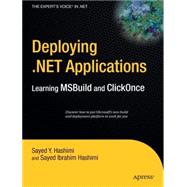
Note: Supplemental materials are not guaranteed with Rental or Used book purchases.
Purchase Benefits
What is included with this book?
| About the Authors | xi | ||||
| About the Technical Reviewer | xiii | ||||
| Acknowledgments | xv | ||||
| Introduction | xvii | ||||
| CHAPTER 1 Deployment Prerequisites | 1 | (20) | |||
|
1 | (13) | |||
|
2 | (4) | |||
|
6 | (3) | |||
|
9 | (1) | |||
|
10 | (1) | |||
|
11 | (2) | |||
|
13 | (1) | |||
|
13 | (1) | |||
|
14 | (3) | |||
|
14 | (1) | |||
|
15 | (1) | |||
|
16 | (1) | |||
|
17 | (1) | |||
|
17 | (2) | |||
|
18 | (1) | |||
|
18 | (1) | |||
|
19 | (2) | |||
| CHAPTER 2 The Unified Build Engine: MSBuild | 21 | (24) | |||
|
22 | (2) | |||
|
22 | (1) | |||
|
23 | (1) | |||
|
24 | (19) | |||
|
26 | (1) | |||
|
27 | (10) | |||
|
37 | (6) | |||
|
43 | (2) | |||
| CHAPTER 3 MSBuild: By Example | 45 | (30) | |||
|
45 | (3) | |||
|
48 | (6) | |||
|
54 | (1) | |||
|
55 | (2) | |||
|
57 | (2) | |||
|
59 | (4) | |||
|
63 | (1) | |||
|
63 | (6) | |||
|
69 | (5) | |||
|
74 | (1) | |||
| CHAPTER 4 Extending MSBuild | 75 | (32) | |||
|
75 | (31) | |||
|
77 | (8) | |||
|
85 | (21) | |||
|
106 | (1) | |||
| CHAPTER 5 Introducing Team Foundation Server and Team Build | 107 | (30) | |||
|
107 | (1) | |||
|
108 | (1) | |||
|
108 | (2) | |||
|
109 | (1) | |||
|
110 | (1) | |||
|
110 | (1) | |||
|
110 | (1) | |||
|
110 | (1) | |||
|
110 | (2) | |||
|
111 | (1) | |||
|
112 | (5) | |||
|
113 | (1) | |||
|
113 | (1) | |||
|
114 | (1) | |||
|
114 | (1) | |||
|
114 | (1) | |||
|
114 | (3) | |||
|
117 | (6) | |||
|
123 | (4) | |||
|
127 | (4) | |||
|
131 | (2) | |||
|
133 | (2) | |||
|
135 | (2) | |||
| CHAPTER 6 Deploying Smart Clients with ClickOnce | 137 | (24) | |||
|
138 | (1) | |||
|
139 | (5) | |||
|
139 | (1) | |||
|
140 | (1) | |||
|
141 | (3) | |||
|
144 | (1) | |||
|
145 | (1) | |||
|
145 | (3) | |||
|
148 | (3) | |||
|
151 | (3) | |||
|
154 | (5) | |||
|
155 | (2) | |||
|
157 | (2) | |||
|
159 | (2) | |||
| CHAPTER 7 ClickOnce Updates, Security, and the Bootstrapper | 161 | (24) | |||
|
161 | (3) | |||
|
164 | (2) | |||
|
166 | (3) | |||
|
167 | (1) | |||
|
167 | (2) | |||
|
169 | (12) | |||
|
170 | (2) | |||
|
172 | (1) | |||
|
173 | (2) | |||
|
175 | (4) | |||
|
179 | (2) | |||
|
181 | (1) | |||
|
181 | (2) | |||
|
181 | (2) | |||
|
183 | (2) | |||
| CHAPTER 8 The ClickOnce Data Directory and Deploying Prerequisites | 185 | (34) | |||
|
185 | (5) | |||
|
190 | (10) | |||
|
200 | (1) | |||
|
201 | (16) | |||
|
205 | (5) | |||
|
210 | (7) | |||
|
217 | (2) | |||
| CHAPTER 9 ClickOnce Tools and Scenarios | 219 | (34) | |||
|
219 | (9) | |||
|
228 | (4) | |||
|
229 | (1) | |||
|
229 | (1) | |||
|
230 | (1) | |||
|
231 | (1) | |||
|
232 | (5) | |||
|
233 | (2) | |||
|
235 | (2) | |||
|
237 | (8) | |||
|
237 | (2) | |||
|
239 | (6) | |||
|
245 | (7) | |||
|
245 | (1) | |||
|
246 | (3) | |||
|
249 | (1) | |||
|
250 | (1) | |||
|
250 | (1) | |||
|
251 | (1) | |||
|
252 | (1) | |||
| INDEX | 253 |
The New copy of this book will include any supplemental materials advertised. Please check the title of the book to determine if it should include any access cards, study guides, lab manuals, CDs, etc.
The Used, Rental and eBook copies of this book are not guaranteed to include any supplemental materials. Typically, only the book itself is included. This is true even if the title states it includes any access cards, study guides, lab manuals, CDs, etc.